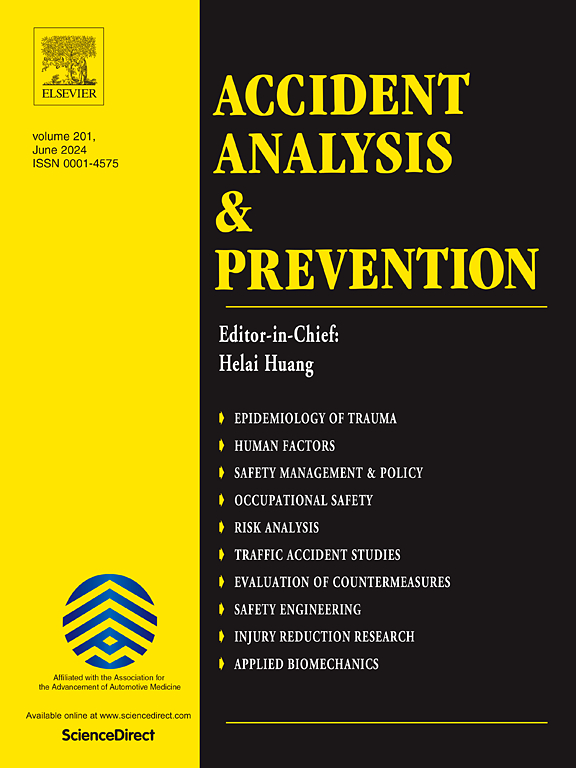基于极值理论的混合交通环形交叉路口交通冲突分析
IF 5.7
1区 工程技术
Q1 ERGONOMICS
引用次数: 0
摘要
由于碰撞数据不可用或不可靠,中低收入国家非车道异构交通条件下的环形交叉路口安全评估面临挑战,因此转向使用安全替代品。本研究采用高分辨率无人机视频和先进的图像处理技术来提取车辆轨迹。使用替代安全措施(SSMs),即碰撞时间(TTC)和碰撞后(假设)最大速度差(MaxDeltaV)来识别交通冲突。使用极值理论(EVT)确定TTC (1.25 s)和MaxDeltaV (4.5 m/s)的阈值。通过使用由联邦公路管理局(FHWA)开发的替代安全评估模型(SSAM)工具中确定的阈值,将冲突分为变道(42%)、追尾(33%)和穿越(25%)类型。采用负二项目标函数建立AdaBoost回归模型进行冲突频率预测。SHAP分析显示,环形道路宽度的增加减少了冲突的频率,而更高的冲突和接近的交通量增加了冲突的可能性。基于TTC和MaxDeltaV值,分层和两步聚类技术将识别出的冲突分为四个严重级别:低(33.8%)、中(34.1%)、高(19.3%)和非常严重(12.8%)。有序Probit模型基于几何、交通、建筑环境因素和冲突类型预测冲突严重程度,预测准确率为88.4%。较大的中心岛屿直径和循环道路宽度降低了严重程度,而较高的平均速度则增加了冲突的严重程度。本研究提出了一个新的框架,应用EVT建立混合交通下无信号环形交叉路口的SSM阈值,整合先进的统计和机器学习技术,主动评估冲突频率和严重程度。本文章由计算机程序翻译,如有差异,请以英文原文为准。

Advanced traffic conflict analysis for safety evaluation at roundabouts under mixed traffic using extreme value theory
Roundabout safety evaluation in non-lane-based, heterogeneous traffic conditions in low-middle-income countries brings challenges due to unavailable/unreliable crash data, thereby switching to the utilization of safety surrogates. This study employed high-resolution drone videos and advanced image-processing techniques to extract vehicular trajectories. Traffic conflicts were identified using Surrogate Safety Measures (SSMs), namely, Time-to-Collision (TTC) and maximum post-collision (hypothetical) velocity difference (MaxDeltaV). Extreme Value Theory (EVT) was used to determine threshold values for TTC (1.25 s) and MaxDeltaV (4.5 m/s). By employing the determined thresholds in the Surrogate Safety Assessment Model (SSAM) tool developed by the Federal Highway Administration (FHWA), conflicts were classified into lane-change (42 %), rear-end (33 %), and crossing (25 %) types. An AdaBoost regressor model was developed using a negative binomial objective function for conflict frequency prediction. SHAP analysis revealed that increased circular road widths reduced conflict frequency, while higher conflicting and approaching traffic volumes increased the likelihood of conflicts. Based on TTC and MaxDeltaV values, hierarchical and two-step clustering techniques classified the identified conflicts into four severity levels: low (33.8 %), moderate (34.1 %), high (19.3 %), and very high severity (12.8 %). An Ordered Probit model predicted conflict severity based on geometric, traffic, built-environmental factors, and conflict types, with a prediction accuracy of 88.4 %. Larger central island diameters and circulatory road widths reduced severity, while higher average speeds increased conflict severity. This research presents a novel framework that applies EVT to establish SSM thresholds for unsignalized roundabouts under mixed traffic, integrating advanced statistical and machine learning techniques to assess conflict frequency and severity proactively.
求助全文
通过发布文献求助,成功后即可免费获取论文全文。
去求助
来源期刊

Accident; analysis and prevention
Multiple-
CiteScore
11.90
自引率
16.90%
发文量
264
审稿时长
48 days
期刊介绍:
Accident Analysis & Prevention provides wide coverage of the general areas relating to accidental injury and damage, including the pre-injury and immediate post-injury phases. Published papers deal with medical, legal, economic, educational, behavioral, theoretical or empirical aspects of transportation accidents, as well as with accidents at other sites. Selected topics within the scope of the Journal may include: studies of human, environmental and vehicular factors influencing the occurrence, type and severity of accidents and injury; the design, implementation and evaluation of countermeasures; biomechanics of impact and human tolerance limits to injury; modelling and statistical analysis of accident data; policy, planning and decision-making in safety.
 求助内容:
求助内容: 应助结果提醒方式:
应助结果提醒方式:


